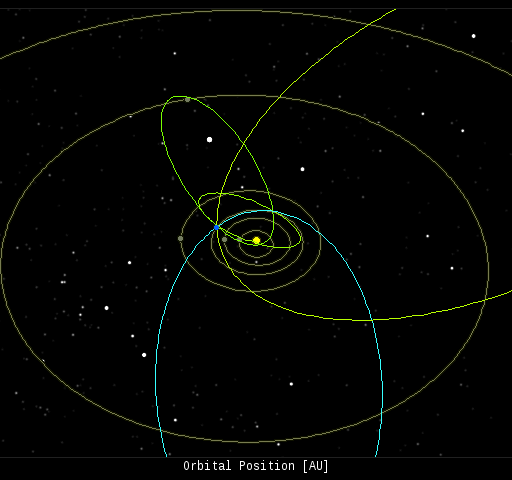When is the best time to see auroras? Where is the best place to go? And how do you photograph them? These questions and more are answered in a new book, Northern Lights - a Guide, by Pal Brekke & Fredrik Broms. | | | WEEKEND OUTLOOK: NOAA forecasters estimate a 50% chance of geomagnetic storms this weekend in response to CMEs due to arrive on Saturday and Sunday. Both CMEs are minor, but the 1-2 punch could cause magnetic disturbances around the poles. High-latitude sky watchers should remain alert for auroras. Aurora alerts: text, voice RETURNING SUNSPOT STILL ACTIVE: Near the end of January, sunspot AR1967 emerged over the sun's eastern limb and unleashed almost two dozen M-class solar flares as it crossed the solar disk. Is it about to happen again? This weekend, the long-lived sunspot is due to return from the farside of the sun. Moreover, a farside CME that billowed over the eastern limb on Feb. 21st suggests that AR1967 is still active: 
If AR1967 reappears as expected it will mark the third time the active region has crossed the face of the sun. The first time was in early January when it was called AR1944. Sunspots seldom last more than two or three weeks; two or three months is remarkable. By now the returning spot is probably a decayed shell of its former self, although the CME hints at some remaining potency. Stay tuned for updates as the sun's rotation turns the active region toward Earth in the days ahead. Solar flare alerts: text, voice Realtime Space Weather Photo Gallery MYSTERY CLOUD (DE-MYSTIFIED): On the night of Feb. 20/21, photographer Dennis Mammana was stationed on Pedro Dome near Fairbanks, Alaska, in hopes of recording the Northern Lights. "I caught this instead—a tiny and bright cloud that rose from the western sky and spread slightly and faded over an hour or so," says Mammana. Here is a composite of two of his shots:

The cloud resembles a rocket fuel dump. Scientists from the University of Alaska frequently launch rockets from the nearby Poker Flat Research Range to study auroras. But on this night there were no rocket launches on Poker Flat. Update: There was, however, a launch thousands of miles away. A Delta 4 rocket blasted off from Cape Canaveral carrying a GPS satellite. Veteran satellite watcher Marco Langbroek says this is it: "The mystery object on the Mammana photo from Pedro Dome near Fairbanks, Alaska, is a fuel vent from the Feb 20 launch of GPS 2F-05 (USA 248, 20114-008A, #39533)." "Although the satellite is in an orbit with a 54.98 degree inclination, that does not mean it was not visible from Mammana's location at 65N," he continues. "It is in a very high orbit and was at an altitude of over 20,000 km at that moment. At such an altitude it is visible from 65 N, low in the west in this case." The attached sky map prepared by Langbroek shows the position of the satellite (labeled "Object A") in the sky above Alaska at the time Mammana photographed the cloud. The sky map and the photo are a good match. Realtime Aurora Photo Gallery
Realtime Comet Photo Gallery
Every night, a network of NASA all-sky cameras scans the skies above the United States for meteoritic fireballs. Automated software maintained by NASA's Meteoroid Environment Office calculates their orbits, velocity, penetration depth in Earth's atmosphere and many other characteristics. Daily results are presented here on Spaceweather.com. On Feb. 22, 2014, the network reported 5 fireballs.
(5 sporadics) 
In this diagram of the inner solar system, all of the fireball orbits intersect at a single point--Earth. The orbits are color-coded by velocity, from slow (red) to fast (blue). [Larger image] [movies] On Feb. 21, 2014, the network reported 24 fireballs.
(24 sporadics) 
In this diagram of the inner solar system, all of the fireball orbits intersect at a single point--Earth. The orbits are color-coded by velocity, from slow (red) to fast (blue). [Larger image] [movies]
Potentially Hazardous Asteroids ( PHAs) are space rocks larger than approximately 100m that can come closer to Earth than 0.05 AU. None of the known PHAs is on a collision course with our planet, although astronomers are finding new ones all the time. On February 22, 2014 there were potentially hazardous asteroids. Notes: LD means "Lunar Distance." 1 LD = 384,401 km, the distance between Earth and the Moon. 1 LD also equals 0.00256 AU. MAG is the visual magnitude of the asteroid on the date of closest approach. | | The official U.S. government space weather bureau | | | The first place to look for information about sundogs, pillars, rainbows and related phenomena. | | | Researchers call it a "Hubble for the sun." SDO is the most advanced solar observatory ever. | | | 3D views of the sun from NASA's Solar and Terrestrial Relations Observatory | | | Realtime and archival images of the Sun from SOHO. | | | from the NOAA Space Environment Center | | | the underlying science of space weather | | 
